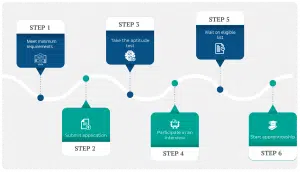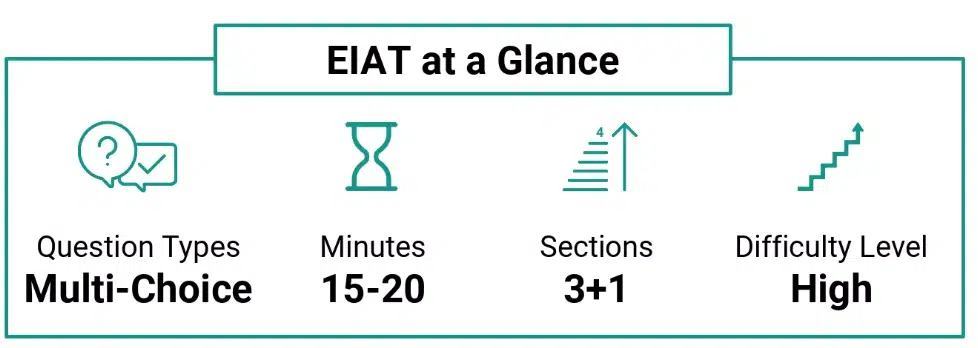iPREP is a trusted test‑prep provider offering a full (EIAT) Elevator Industry Aptitude test prep course, and on this page you can access free sample questions with full explanations and video walkthroughs.
You’ll get:
- Free real‑style Elevator Aptitude questions
- Instant right/wrong feedback
- Step‑by‑step written solutions
- Short video explanations for every answer
Test Breakdown with Sample Questions
Most of the aptitude tests feature a combination of different formats that serve to analyze your abilities. They provide an informative report to the employer that helps them determine how to best train the candidate.
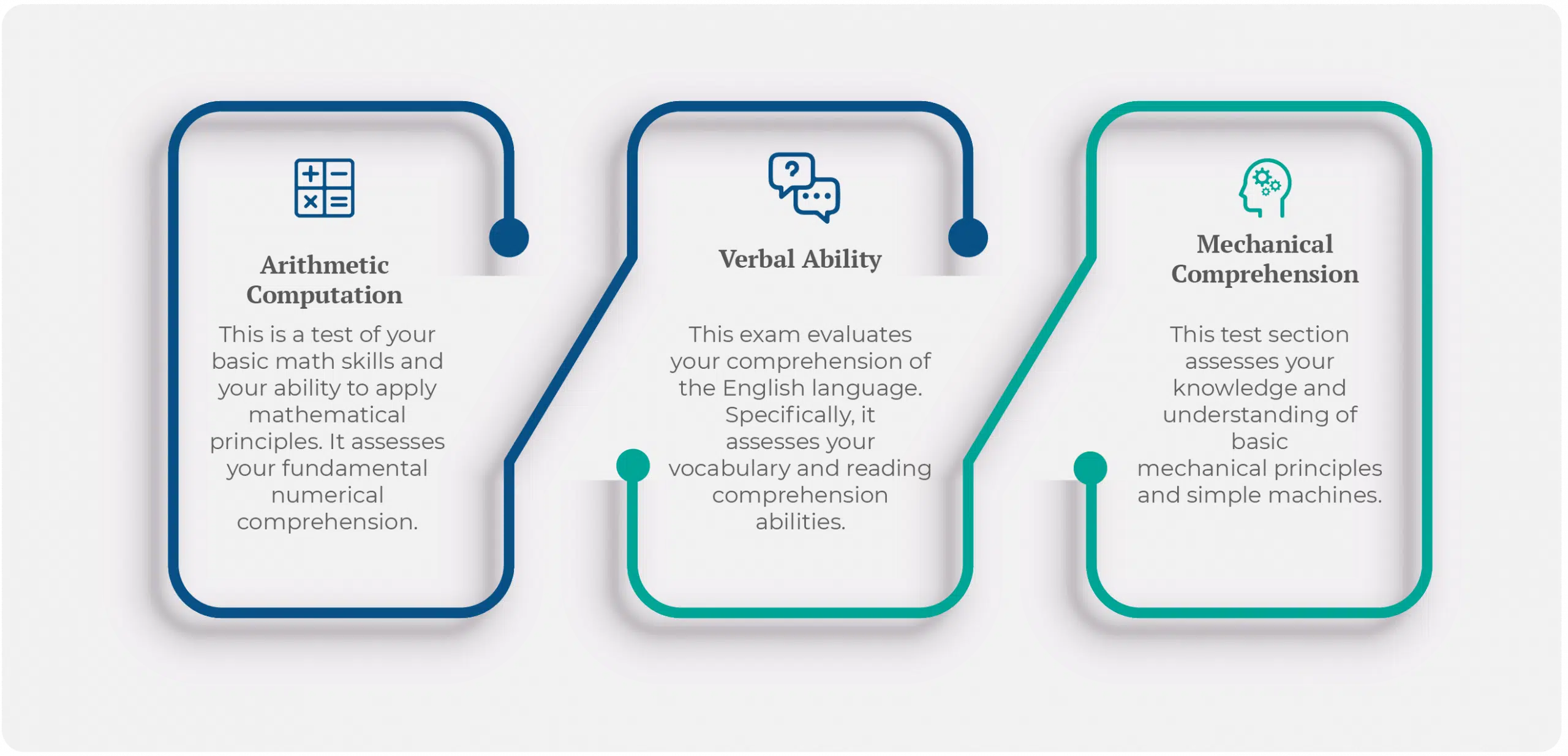
The Elevator Industry Aptitude Test (EIAT) is no exception. It consists of three test sections: 1. Arithmetic Computation; 2. Verbal Ability; 3. Mechanical Comprehension. The following segment provides a description of each of the tests and the types of questions included in them. It introduces various methods which explain how to approach each type of question and provides some sample test questions.
#1 Arithmetic Computation
This is a test of your basic math skills and your ability to apply mathematical principles. It assesses your fundamental numerical comprehension.
In order to solve the questions on this test, you must have a complete command of the elementary operations. You must also know how to approach and solve problems that involve fractions and decimals.
The most common questions that comprise this section are
- The four basic mathematical operations (addition, subtraction, multiplication, and division) and the order of operations.
- Problems with fractions and decimals, including long numbers.
Winning Tip For Arithmetic Computations
Instead of fully performing complicated calculations, you can round off the factors to get an estimated outcome. This outcome will allow you to eliminate options that are improbable.
Sample Questions
Arithmetic Computation Sample 1
Which of the following has the lowest value?
- 1/4 + 0.2
- 0.32 + 0.19
- 2/5 + 0.1
- 1/2 – 0.01
- 1/3 + 1/6
The correct answer is 1/4 + 0.2
Explanation: In questions that involve expressions comprised of both decimals and fractions, it is usually easier to convert all expressions to decimals and only then to compare them. An exception is the last expression, which is more easily simplified by finding a common denominator.
- 1/4 + 0.2 = 0.25 + 0.2 = 0.45 → the lowest value
- 32 + 0.19 = 0.51
- 2/5 + 0.1 = 0.4 + 0.1 = 0.5
- 1/2 – 0.01 = 0.5 – 0.01 = 0.49
- 1/3 + 1/6 = 2/6 + 1/6 = 3/6 = 1/2 = 0.5
Arithmetic Computation Sample 2
What is the value of the following expression?
32 – 16 / 4 + ((5 x 3)2 – 10) / 5 = ?
The value of the expression is
The value is 71.
| 32 – 16 / 4 + ((5 x 3)2 – 10) / 5 | Two parentheses. Start with the inner parentheses. |
| 32 – 16 / 4 + (152 – 10) / 5 32 – 16 / 4 + (225 – 10) / 5 | Solve second parentheses. Inner order is also PEMDAS, so start with the exponent. Then, continue with subtraction |
| 32 – 16 / 4 + 215 / 5 | Moving to multiplication and division. Since these are separated by +/- signs, there’s no significance to solving left to right |
| 32 – 4 + 43 28 + 43 = 71 | Completing with addition and subtraction, left to right. |
| This is the same result as the first one by chance. |
#2 Verbal Ability
This exam evaluates your comprehension of the English language. Specifically, it assesses your vocabulary and reading comprehension abilities. The texts provided may not necessarily relate to the field of elevator mechanic apprenticeships and can instead focus on a variety of topics, such as history, literature, news, and personal correspondence.
The test includes two main types of questions:
- Word Meaning – In these questions, you will be shown a brief text with some words highlighted. Your task is to determine the word’s meaning within that particular context and select the answer that best represents this meaning.
Sentence Completion – In these questions, you will be shown a brief text with one or two missing words. Your objective will be to select the best word or words to fill in the blank(s) from the given options.
Winning Tip For Verbal Ability Test
Verbal ability tests are deliberately written in a complex form, and it is common to misunderstand a statement when you first read it. Ensure that you read each sentence twice or even thrice to get a better understanding of what it’s trying to convey.
Sample Questions
Verbal Ability Sample 1
Choose the word or the words that, when inserted in the sentence to replace the blank or the blanks, best fits the meaning of the sentence.
With a location that was blocked to traffic by ongoing construction work, the owners of the store had dire expectations regarding his revenue; however, with the implementation of electronic commerce, the location proved not to be as ___________ as originally thought.
- auspicious
- contingent
- opportune
- disadvantageous
- unmanageable
The correct answer is “disadvantageous”.
After analyzing the sentence, you should convert it a very “reduced” version; here is an example:
“The owners were afraid it was going to be bad, but it was not as ___ as originally thought.”
Here you should know that you want a term that means “bad,” but none of the words may be the words that initially pop to mind.
The correct answer, “disadvantageous,” is a long word you can initially disregard. However, inspecting the word will reveal that it contains both a prefix and a suffix:
“Dis” means “Not (something).” “–eous” turns the noun into an adjective.
The remaining core is “advantage” which means “good.”
With the prefix and suffix, the meaning of the word becomes “not-good (something)” or simply “bad.”
The meaning of the other words:
Auspicious and opportune mean lucky or advantageous or simply “good.”
Unmanageable (wild) and contingent (conditional/possible) do not create a meaningful enough sentence.
Verbal Ability Sample 2
What is the meaning of the underlined word?
I was absolutely famished! The aroma of food I was smelling as I walked down the street didn’t help my state.
- quite furious
- extremely hungry
- exhausted
- extremely happy
The correct answer is B.
The correct meaning of the word can be derived based on an informational context clue.
“I was absolutely famished! The aroma of food I was smelling as I walked down the street didn’t help my state.”
While the speaker was walking down the street, the smell of food did not help their situation, because they were so hungry.
#3 Mechanical Comprehension
This test section assesses your knowledge and understanding of basic mechanical principles and simple machines. It also evaluates your ability to apply this knowledge in order to solve math problems that rely on mechanical comprehension. The questions do not require any professional knowledge of elevator mechanics.
Mechanical Comprehension questions usually involve one or more of the following:
- Knowledge and understanding of simple machines – levers, pulleys, wedges, screws, etc.
- Basic tools recognition
- Solving questions that require basic mechanical comprehension, including concepts of gears, the pressure of fluids, etc.
Winning Tip for Mechanical Comprehension
Get familiar with introductory physics terms like gravity, friction, inertia, and centrifugal and centripetal force, as the function of most tools depends upon these phenomena. Therefore, having a basic understanding of them will help solve the questions in this section.
Sample Questions
Mechanical Comprehension Sample 1
If bar A moves right at a speed of X, how does bar B move?

- Left, slower than X
- Right, slower than X
- Right, same speed
The correct answer is C – right, same speed.
When the bar A moves to the right with speed X, it also gives a tangential speed X to gear L since they are directly meshed. Gear L moves clockwise, which rotates the gear M counterclockwise. Since gear L and M are directly meshed, they have the same tangential speed X.
Now, gear M rotates gear N clockwise with the same tangential speed and similarly, gear N rotates gear O counterclockwise with tangential speed X. Gear O will move bar B along with it in the right direction with the same tangential speed X.

Mechanical Comprehension Sample 2
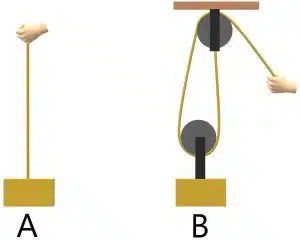
Compared to the regular lifting of the load (A), how much effort is required to lift the load with the pulley (B)?
- Same effort as regular lifting
- Half the original effort
- One-third of the original effort
The correct answer is B.
When the load is hung from the string, it generates tension (T) in the string and the effort required to lift the load equals that tension in the string. In regular lifting (case A), the tension in the string equals the weight (W) of the load, therefore, the required effort (F) is F = W.
By using a pulley (case B), the tension in the string is divided into the number of strings used to lift the load. In our case, the number is two, as shown in the figure. So, the tension in the string is equal to half the weight of the load W. this shows that the required effort is F = W/2, which is half that in case A.
Hence we can conclude that tension is halved by using the given pulley.
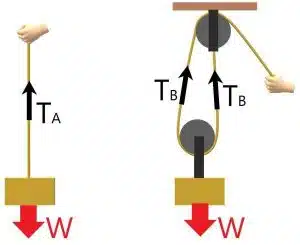
Did you know?
The NEIEP Elevator Aptitude Test is composed of three sections: (1) reading comprehension, (2) mechanical comprehension, and (3) arithmetic computation. The test is pass/fail and requires a score of 70% or higher to pass. Those who pass will face a tool recognition test and an interview. High scorers improve their chances of being called for an interview.
Preparation Strategies
Learn How to Approach Multiple-Choice Questions
The strategy for approaching EIAT MCQ questions is slightly different as compared to other tests. Unlike other assessments, no penalties are implemented for choosing a wrong answer in an EIAT; points are only awarded for selecting the correct one. This means it’s best to guess the answer, even if you’re not sure if you are correct. Keep in mind that there is a time limit on the test so it’s best not to spend too much time on a particular question.
However, while guessing is worth considering, random guessing is not. If you are unsure about the correct option, try using the elimination strategy. Eliminate every possibility that you think is not correct. This will leave you with fewer options to choose from, streamlining the guesswork. When solving MCQs, elimination is one of the most crucial principles. If you come across enough evidence to eliminate every option except one, go for it.
Keep the Stress Level Down
Stress can affect your ability to think clearly. Tackle every question as it appears on the test and avoid getting overwhelmed by the exam’s nature. If you are not able to clear the exam on the first attempt, you can always retake it. Although it is crucial to perform well in the exam, one failure does not mean you have no future in the elevator industry, so don’t stress out.
There are different methods to help you calm down on the day of the assessment. However, being well-prepared and confident will considerably reduce your stress levels.
Go for an Online Preparation Course
Being well-prepared for the test means studying in advance. An online preparation course will help you to get familiar with the test format, construct an effective strategy, and reduce stress. Unlike offline courses, online courses provide more updated information. They are very convenient as you are provided with pre-recorded study material which you can study at your convenience. They are also time-efficient.

Practice to Discover the Scope for Improvement
While studying is important, practice is also essential for any aptitude test. This means you should actually practice taking sample tests. This will make you more familiar with the exam’s nature and help you to be better prepared to face the questions.
It’s recommended that you take a few practice tests to make yourself aware of the areas you are struggling with. For example, you may have a good mechanical understanding of the industry, but your arithmetic computation can use some work. Take the time to focus on your weaker areas while taking your practice exams.
Get Familiar With Answering Questions Without a Calculator
It’s important to note that calculators are not allowed in the exam room. Therefore, you must get familiar with manual calculation. Training will help you calculate faster and develop your non-calculator skills.
Prepare Strategy According to the Time Limit
Time management is a major factor in the EIAT exam. A significant amount of fairly simple questions must be solved in a limited amount of time. Hence, passing the test calls for the development of fast-solving techniques, especially in the arithmetic computation section.
EIAT/NEIEP Test Features
Fast Facts (tl;dr)
- Three Test Section
- Arithmetic Computation (25-35 questions)
- Verbal Ability Test (25-35 questions)
- Mechanical Comprehension (25-35 questions)
- 15-20 minutes long
- Multiple-choice questions for most items; arithmetic computation questions may require inserting an answer without choices
- A score of 70% or more to pass
- Question types: reading comprehension, mechanical comprehension, and arithmetic computation
- Calculators are not permitted
- Bring a valid ID proof
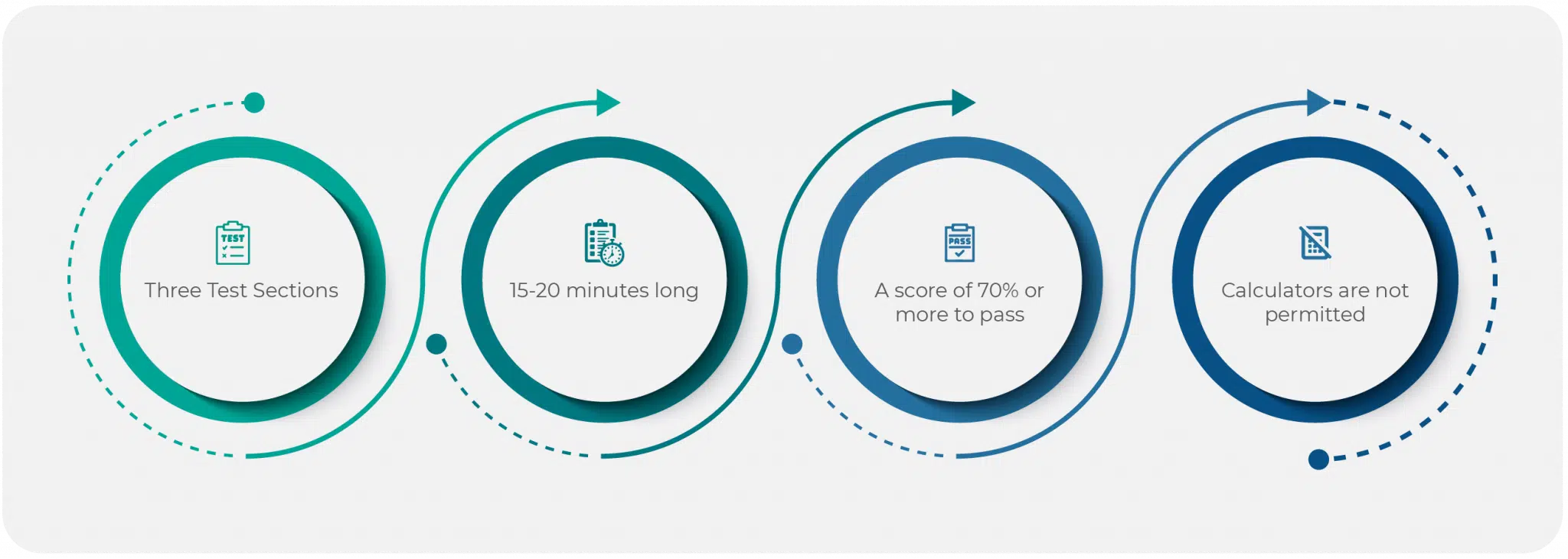
Step-1 of a Three-Step Application Process
The EIAT is the initial screening stage for people looking to be Elevator Constructor Apprentices. Once you pass the test, you move on to be tested for your tool recognition skills. The interview is the final stage of the process. If you pass, you will be eligible to become an Elevator Constructor Apprentice.
No Penalty for Wrong Answers
There is no penalty for marking an incorrect option. Therefore, leaving a question blank is not recommended. It’s better to take a guess as it will provide you with a better chance of passing the test.
Possible to Retake
Applicants who are not able to score minimum passing marks do not qualify for further rounds. However, it is possible to retake the exam in the subsequent recruitment period.
Common and Past Names of the Test
The name of the EIAT exam has been altered a few times over the years. Moreover, individuals throughout the world tend to call the exam by different names. Here are some names that may be used to identify the EIAT exam:
- Elevator Test
- Elevator Industry Aptitude Test
- Elevator Mechanic Apprenticeship Entrance Exam
- Elevator Mechanics Exam
- Elevator Apprenticeship Test
- NEIEP Aptitude Test
- NEIEP Application Test
- Tech Elevator Aptitude Test
- IUEC Aptitude test
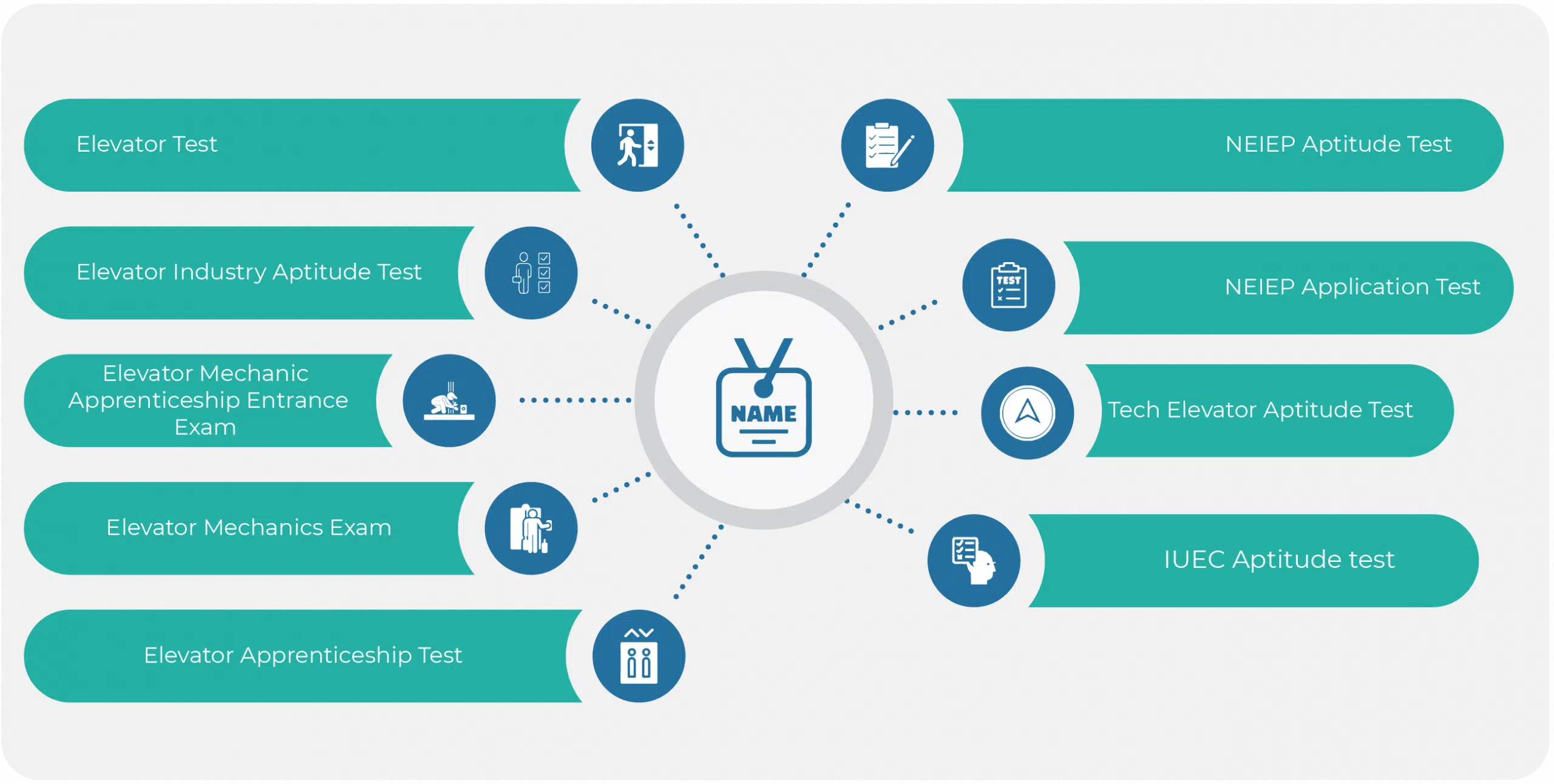
Tool Assessment
Once you clear the EIAT, you proceed to the next step of the process, which involves passing the tool assessment. The scores of the elevator industry tool assessment are not included in the scores of the EIAT. They are kept separate.
The test includes numerous questions framed around tools, including tools’ names, usage, meter readings, etc.
The scores you achieve in the tool assessment will be added to your interview score.
Executing an elevator job requires the use of various power and hand tools. It is crucial for the recruiter to know whether or not an individual is skilled enough to work with these tools. This is determined in the tools assessment section of the test.
An employer will want to know if you are able to handle the necessary tools properly. Additionally, you must be familiar with how to operate them for the following reasons:
- You may be provided with a task or job that demands the utilization of a particular tool, or the time you spend on a job may significantly increase if you do not work with the suitable tool.
- You may be working in a team that is composed of skilled individuals from numerous trades. Even if you are not going to directly use a tool, it is good to be familiar with it as you may be asked to hand over or help with a specific tool.
- The Tool Recognition Test is a part of EIAT, and you won’t land an Elevator Constructor Apprenticeship without cracking the assessment.
iPREP: Concise. Focused. What you need.
Sign up
Immediate access
Practice
Online self-paced
Pass
Ace that Test!
Technical Facts
The Process to Be an Elevator Constructor Apprentice
There are four basic steps that an individual has to go through to be an Elevator Constructor Apprentice:
- Meet the Eligibility Criteria
- Apply to an Apprenticeship
- Crack the EIAT
- Pass an interview
- Complete the apprenticeship and get hired
Let’s further expand on these steps:
Meet the Eligibility Criteria
Every individual applying is required to meet the following criteria set by NEIEP Apprenticeship Standards:
Age: 18 years or older
Education: A high school diploma or a state-approved GED equivalent
Work Authorization: You must be authorized to work in the USA to apply for an Elevator Technician Apprenticeship.
Documentation: The following documents will be required to apply:
- Diploma or GED test result or equivalent verification
- DD-214 copy 4 (for veterans)
Drug Test: You must go through a drug screening test. You will only be accepted for the program if the test result is negative.
Apply to an Apprenticeship
An applicant can complete the initial application on the career page of NEIEP. Upcoming and open Elevator Constructor recruitment for apprenticeships will be visible on this page.
After you have completed the application, you will be redirected to iCims, an Applicant Tracking System which collects and manages the data of every NEIEP applicant.
The application process is similar for most states except New York.
While applying, the system will request you to provide a GED or equivalent document and fill in your details. Once your documents are uploaded and the application is complete, you will be provided with a time and date for taking the EIAT.
Crack the EIAT
Once you have successfully completed the application, the Local Area Coordinator will invite you to take the EIAT via email through the iCims system. This assessment measures the aspects of knowledge which predict your ability to gain the mechanical understanding required by elevator technicians.
After taking the EIAT, you will be required to take the tool assessment which requires you to identify basic working tools.
You must score at least 70% to pass the EIAT.
Pass an Interview
Once you score 70% and have passed the Elevator Aptitude Test, an interview will be scheduled. The interview will be conducted by two interviewers (one from IUEC and the other one from your prospective employer) and will take around 15-20 minutes.
As per the standards set by NEIEP, the same questions must be asked of every candidate.
Complete the Apprenticeship and Get Hired
Since the NEIEP develops the test, it is easy to obtain a job once you have completed your apprenticeship. These are the steps you must take to get hired in the industry:
- Begin the apprenticeship: If you are accepted into the program, you will begin your apprenticeship as an elevator mechanic. You will work alongside experienced elevator mechanics to learn the skills necessary to install, repair, and maintain elevators.
- Complete the program: The length of an apprenticeship program can vary, but most programs take about 4 years to complete. During this time, you will need to complete a certain number of classroom hours and on-the-job training hours. Once you have completed the program, you will be a certified elevator mechanic and you can start working in the field.
- Become a professional elevator mechanic: After completing the apprenticeship program, you will need to pass a certification exam to demonstrate your knowledge and skills. Once you pass the exam, you will receive a certification indicating that you are a qualified elevator mechanic.
- Get employed: The Elevator Apprentice Test is used by many companies, such as IUEC, OTIS, and Skyline. You must pass the test to gain employment at these companies. Often the company you have completed your apprenticeship with may offer you to work for them full-time. But even if the company is not able to hire you, you can still apply for a job in a broad array of organizations. Being a certified elevator mechanic can lead to a rewarding and stable career with opportunities for advancement. Elevator mechanics are in high demand, as there is a need for elevators in a wide range of settings including commercial buildings, hospitals, and residential buildings. Additionally, being a certified elevator mechanic can provide job security, as elevators require regular maintenance and repair to function properly.
Pen Paper-Based Exam
While most of the aptitude tests are computer-based, the EIAT must be taken with pen and paper.
Simple and Candidate Accessible
The test includes simple questions on topics that are commonly taught in high school. To take the test, you must fill out the application form and match the eligibility criteria. If you are able to score the minimum qualifying marks, you will move on to the next round.
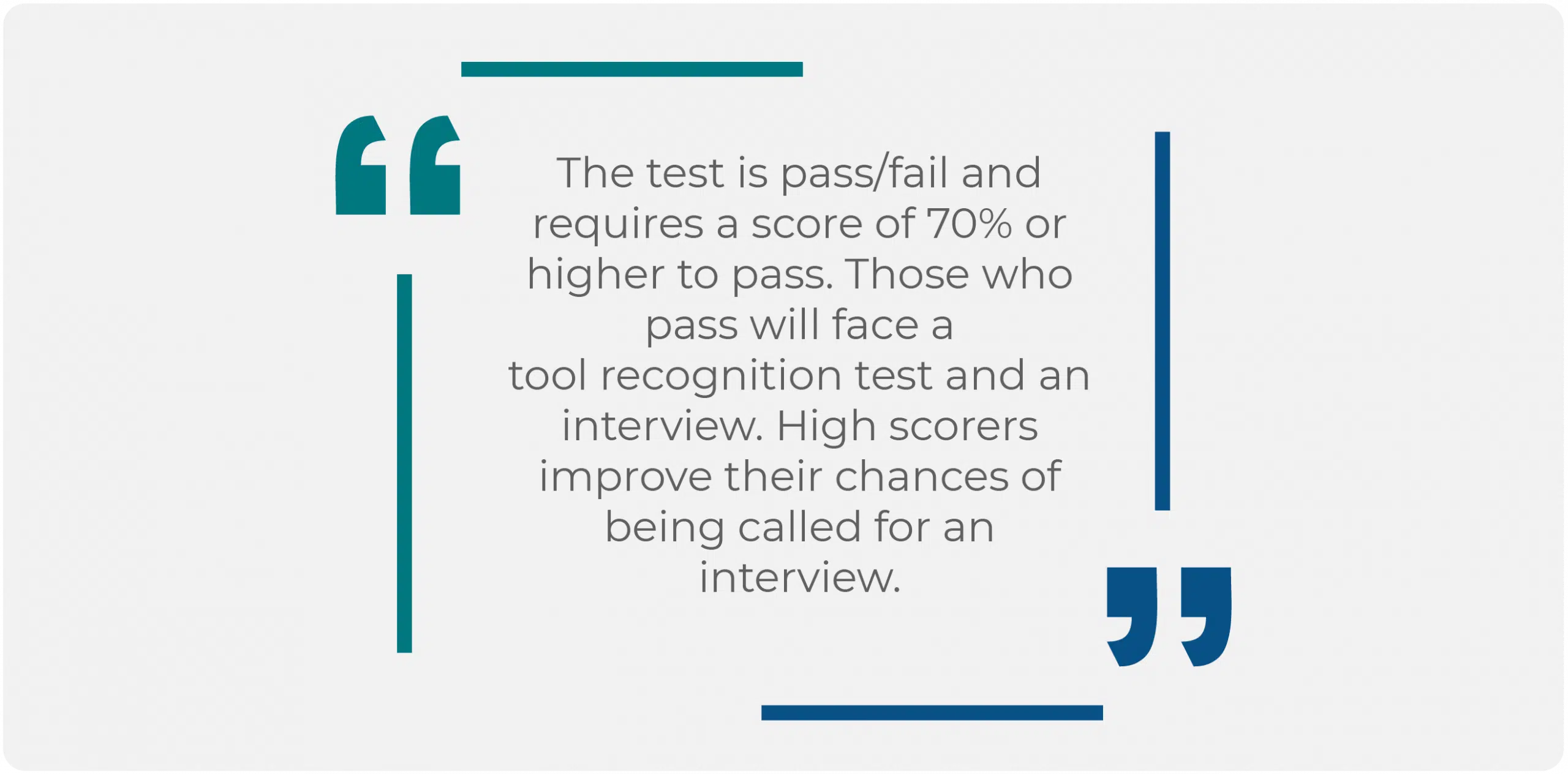
Results Scale and Interpretations
What Is a Good Score – The Fit
Scoring at least 70% on the EIAT is compulsory. If you fail to achieve a minimum of 70 points out of the possible 100, you won’t be able to move to the next stage. However, scoring the bare minimum is often not enough, as employers will likely hire applicants with the best ranking.
The Four Tier Division
The ranking is based on the final score generated after adding up the score of your EIAT, tool test, and interview score. Once the employers have the final scores of all the candidates, they divide them into four different tiers, particularly:
- Tier 1 – 96-100 points
- Tier 2 – 90-95 points
- Tier 3 – 80-89 points
- Tier 4 – 70-79 points
The higher your score, the better the chance an employer will hire you. Practicing is essential.
Eligibility Criteria
There are several requirements that an individual must meet to be eligible for the EIAT. The criteria include the following:
- You must be 18 years or older.
- You must have a school diploma or a state-approved GED equivalent.
- You must be authorized to work in the USA.
- You must pass a drug screening test.
Combined Score
Your final score is based on the marks you get in your:
- EIAT
- Tool Assessment
- Interview Score
These scores will be considered before deciding which tier a candidate’s performance falls into.
What if I Fail the Exam?
If you fail to reach the minimum score you will not be interviewed. However, you can re-apply for the next recruitment period.
EIAT FAQs
The Elevator Industry Aptitude Test (EIAT) is a pre-employment test that measures a candidate’s reading, mechanical, and numerical abilities and includes an in-person interview. Companies will look at the results of both the written test and the interview to determine whether you are a good candidate.
It is imperative to get a high score on the test so recruiters can feel confident hiring you. The test shows your ability to use your previous knowledge fluently and catch on quickly to new tasks.
The EIAT is comprised of a 15-20 minute test and includes multiple-choice questions in three areas:
1. Reading comprehension
2. Mechanical comprehension
3. Arithmetic computation
There is no penalty for answering incorrectly, so it is a good idea to answer even if you’re unsure of the correct answer. Of course, you should try to answer as many questions correctly as you can. Once you have taken the test, you will be notified if you passed. Qualified candidates are then scheduled for an interview.
To apply, a candidate needs to be over the age of 18 and either have his or her high school diploma or GED certificate.
All documents, including the complete apprenticeship application and a copy of the GED certificate or high school diploma, are submitted online.
You will get an exam date within 15 days of the IUEC receiving your application and associated documents.
The IUEC will send you the date and time of your Elevator Industry Aptitude Test once you complete the application, or after your high school transcript or GED results arrive if these are not yet available at the time of your application.
No, you do not have permission to use a calculator in your EIAT test. However, you can use a scratch paper to execute your calculations.
Any candidate who scores below 70 is not eligible for the next stage. To pass the test, you need to answer at least 70% of the questions correctly.
EIAT Test Tips
Get a Strong Hold on Arithmetic
Practice arithmetic as much as possible to improve your calculation speed as calculators are not permitted. Although there’s no penalty for an incorrect response, you have a clock ticking. Learning a few shortcut calculation methods can help.
Work on Your Skills
Practice! Practicing the different sections repeatedly will help you improve your skills and answer more questions correctly within the time limit.
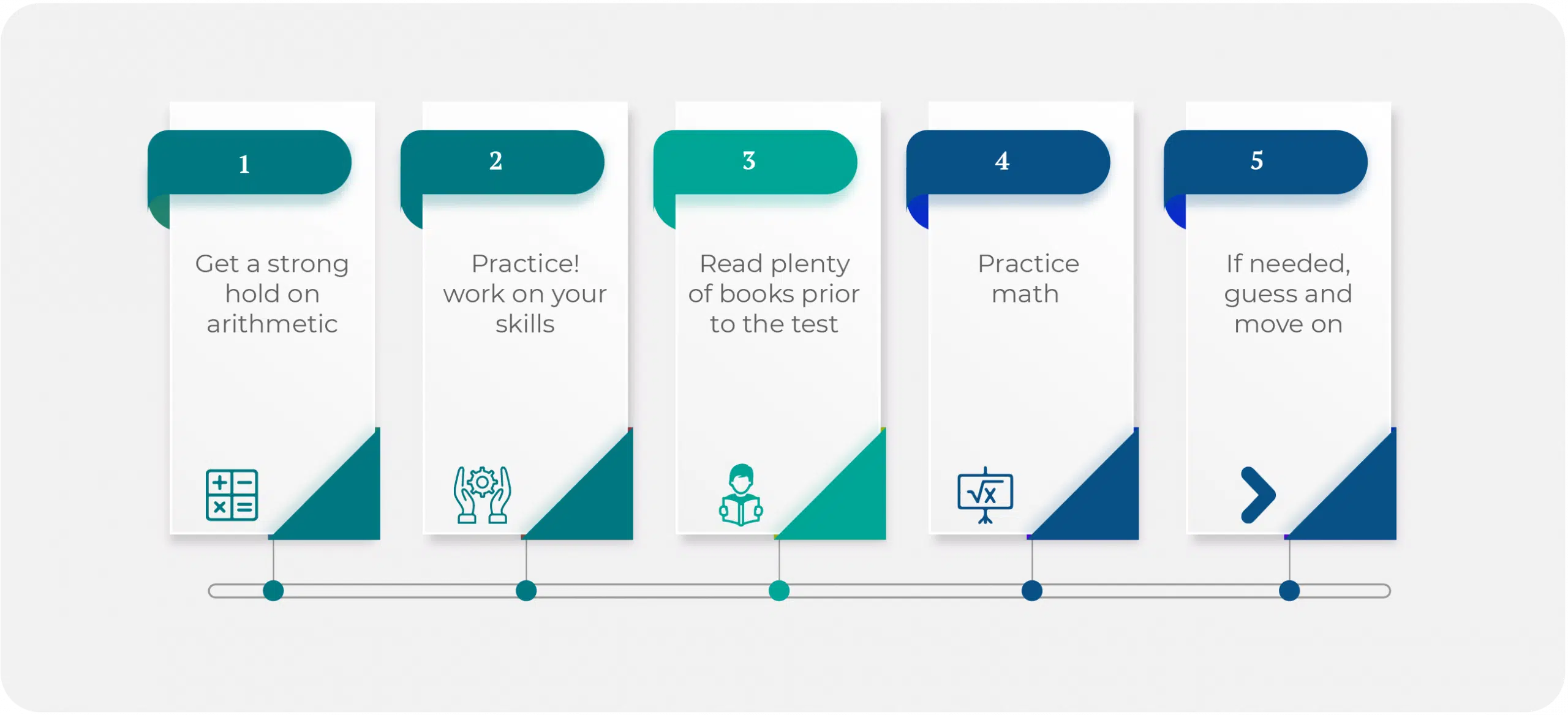
Read Fluently
Read plenty of books prior to the test to improve your reading comprehension (not included in the above sample questions, yet included in the test and in iPrep’s course.)
Practice Math
You will encounter a variety of math questions, including algebra, fractions, addition, subtraction, multiplication, and division. It is essential to practice and sharpen your math skills.
Guess and Move On
Wrong answers will not negatively impact your overall score. Given the time limitation, it’s advisable not to spend too much time on any one question; guess the answer and move on.
Administration
Test Administrator: The International Union of Elevator Construction (IUEC) administers the test.
Test Schedule: The IUEC will send you the date and time of your Elevator Industry Aptitude Test once you complete the application.
Test Format: Mostly multiple choice written test (pen-paper format).
Test Materials: It is a pen-paper-based test, and the use of calculators is not permitted. Writing material will be provided to you at the examination center. However, to be on the safe side, carry a pen.
Retake Policy: If you fail to score 70% on your first EIAT attempt, you can retake the exam in the subsequent recruitment period.
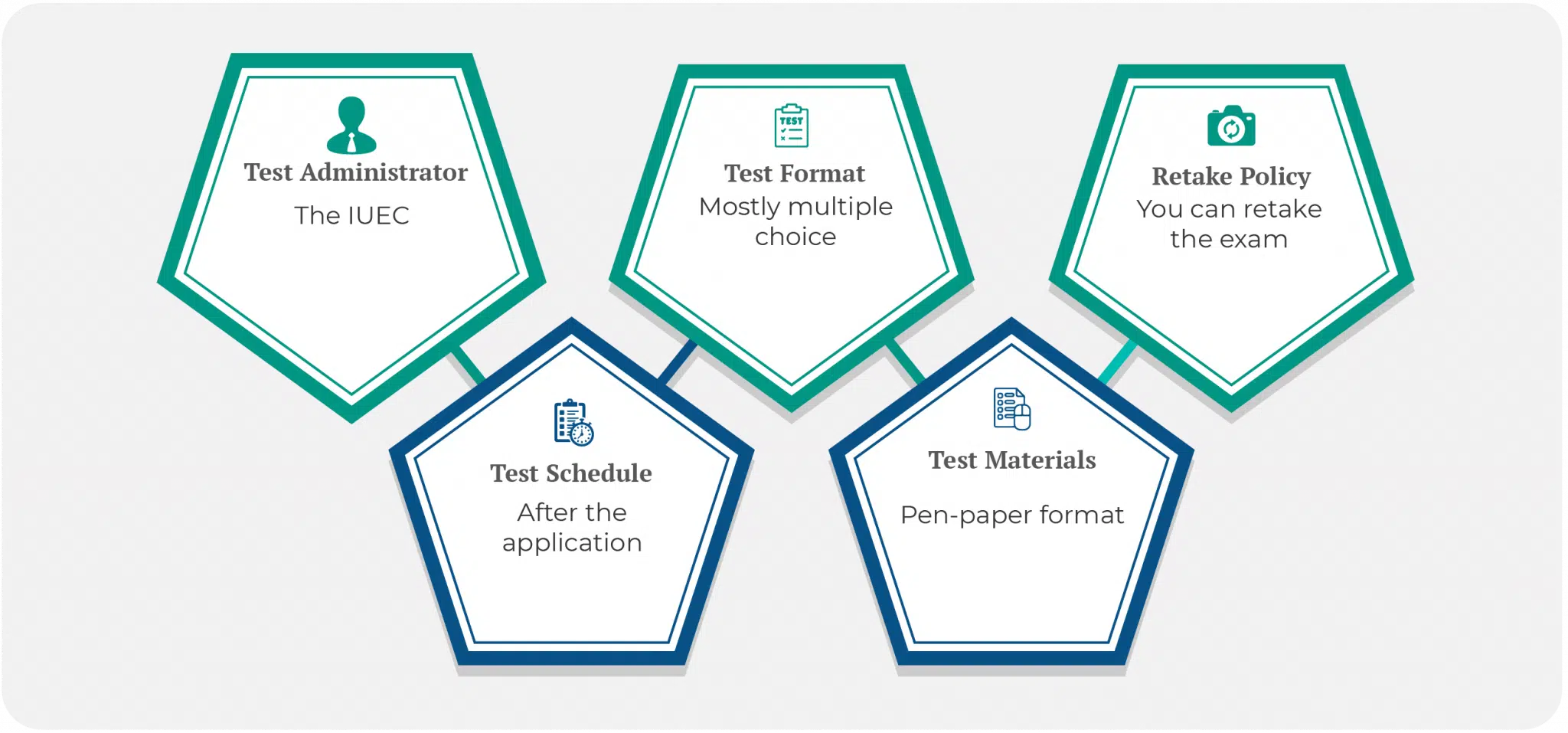
Test Provider
NEIEP, the National Elevator Industry Educational Program, has served the International Union of Elevator Construction (IUEC) for many years. Companies have been relying on NEIEP because of its meticulous curriculum design and evaluation program. NEIEP’s aim is to improve the skills, knowledge, and mechanical skills of the candidates, and to help them get ready for the expected job.
Information Source
- NEIEP – National Elevator Industry Education Program
- IUEC – International Union of Elevator Constructors
Disclaimer – All the information and prep materials on iPrep are genuine and were created for tutoring purposes. iPrep is not affiliated with NEIEP nor with IUEC, the owners of the Elevator Industry Aptitude Test.
Free Elevator practice test: Get to know what the NEIEP Elevator Industry Aptitude Test (EIAT) will be like by practicing with these sample questions:
Question 1 of 10
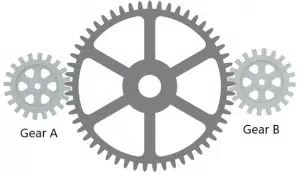
If the middle gear is rotating clockwise, which gear, A or B, will rotate in the same direction?
- Neither A nor B
The correct answer is C – Neither A nor B.
It can be observed from the image that gears A and B are linked directly to the middle gear. However, when two gears are directly linked, their tangential velocities are always the same, although the directions of their rotation are always opposite to each other.
In our case, the velocity vector between the middle gear and gear A will point upwards and the direction of rotation of the middle gear and gear A will be clockwise and counterclockwise respectively. Similarly, the velocity vector between the middle gear G and gear B will point downwards and the rotation of gear B will be counterclockwise. Hence both gears A and B will rotate in the opposite direction of the middle gear.
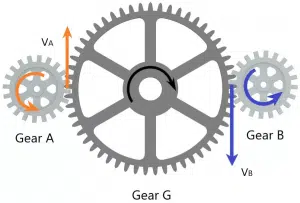
Question 2 of 10

Similar balls are thrown into containers A and B. The ball sinks in container A and floats in container B. Which container is filled with denser liquid?
(If the information is insufficient, mark C.)
- A.
- B.
- C.
The correct answer is B.
When an object is immersed in liquid, a pressure difference is created between its opposite sides. This pressure difference causes a force that pushes the object upwards, known as buoyancy. It is defined as:
Buoyant Force B = density of liquid (ρ) × displaced volume of fluid (V) × gravitational acceleration(g)
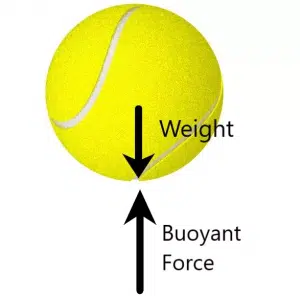
This shows that the denser the liquid, the greater the buoyant force, and the object will be more likely to float. In our case, the liquid in container B must be denser for the same ball to float higher. Forces acting on the ball are shown in the figure.
Question 3 of 10
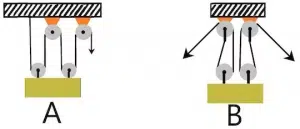
In which case is a stronger force required to lift the load?
(If equal, mark C.)
- A.
- B.
- C.
The correct answer is B.
In the given scenario, the weight is supported by two different mechanisms. In case A, the weight is being lifted with the help of four pulleys joined by a single string, while four parts of the string lift the load. The tension force in the string will be equally divided between the parts of the string. Hence the total effort required to lift the load “W’ will be “W/4.”
In case B, there are two strings, each connected to two pulleys and having two pieces each. The load, in this case, will be divided into two since two strings are being used. First, analyze the left string. The load to be lifted is W/2. The tension in each piece of the string will be half the load, i.e. W/4. The tension in the right string will also be the same. Since two people are pulling in case B, each will require an effort of W/4 and the total effort will be W/2. Hence Case B will require a stronger force in lifting the load.
Question 4 of 10

Which of the two illustrated scenarios is physically possible?
(If both or neither, mark C.)
- A.
- B.
- C.
The correct answer is C – both are possible.
The given scenario shows a class 1 lever balanced in two different cases. We assume load on the right side of the fulcrum and effort on the left. Now, in case A, load and effort are equal and so are the moment arms of both load and effort. This means that the moments of both the load and effort cancel out each other and as a result, the lever is balanced. Hence, case A is very likely to be possible.
In case B, the effort is greater than the load, but the moment arm of effort is smaller than the moment arm of the load. The resultant moment, in this case, will also be zero since the moment is the product of force and moment arm and one factor compensates for the other in this case. Therefore this case is also physically possible.
Therefore, both scenarios are physically possible.
Question 5 of 10
Solve:
$$$\dfrac{1}{2}-\dfrac{2}{9} = ?$$$
- $$$\dfrac{7}{18}$$$
- $$$\dfrac{2}{9}$$$
- $$$\dfrac{1}{3}$$$
- $$$\dfrac{5}{18}$$$
$$$\dfrac{1}{2}-\dfrac{2}{9}$$$ The LCM is 18
$$$\dfrac{1\times9}{2\times9}-\dfrac{2\times2}{9\times2}$$$
$$$\dfrac{9}{18}-\dfrac{4}{18}$$$ Subtract the numerators
$$$\dfrac{9-4}{18}$$$
$$$\dfrac{5}{18}$$$
Question 6 of 10
Write the solution in the box below:
434 ÷ 31 = ?
Type your answer here:The correct answer is 14.
As 31 is clearly higher than 4, you may begin the long division by asking yourself how many times 31 goes into 43 (the first two digits). Then, you bring down the last digit 4. If you are not certain about the answer, it is recommended to subtract 31 from the remainder of the dividend and count how many times you had to repeat the action to reach a remainder of zero.

Question 7 of 10
Which of the following has the lowest value?
- 1/3 + 1/6
- 1/5 + 1/8
- 1/2 + 1/10
- 1/4 + 1/7
The correct answer is 1/5 + 1/8.
Explanation:
In this problem, you may try to calculate the exact value of each expression, but two observations may help you quickly figure out which expression has the lowest value.
- First observation – only 1/2 + 1/10 is an expression higher than 1/2 and it can be eliminated.
- Second observation – recall that in any comparison of fractions with equal numerators, the fraction with the higher denominator has the lower value. If you compare the expression 1/5 + 1/8 to the other two options, it has two fractions that respectively have lower values than the components of the other expressions (i.e. 1/5 is smaller than both 1/3 and 1/4 AND 1/8 is smaller than both 1/6 and 1/7); therefore, it must have the lowest value overall.
The complete calculation of the expressions:
- 1/3 + 1/6 = 2/6 + 1/6 = 3/6 = 1/2 = 0.5
- 1/5 + 1/8 = 0.2 + 0.125 = 0.325
- 1/2 + 1/10 = 0.5 + 0.1 = 0.6
- 1/4 + 1/7 = 0.25 + 0.143~ = 0.393~
Question 8 of 10
Which of the following has the highest value?
- 4.119
- 0.7489
- 3.981
- 3.69899
- 3.096
The correct answer is 4.119
Explanation: The first thing you should do when you encounter questions of this type is to check the value of the integer part. The number with the highest integer value always points to the number with the highest value overall. If some answers have the same value for the integer part, then the highest value is determined by the value of the leftmost decimal digit, the one closest to the decimal point. If the leftmost decimal digit is also identical, the highest value is determined by the next decimal digit, etc.
In this case, answer A has the highest integer part value – 4, thus it is the correct answer.
Question 9 of 10
Choose the word or the words that, when inserted in the sentence to replace the blank or the blanks, best fits the meaning of the sentence.
Most parents thought it was an __________ decision to make the field trip part of the yearly routine, as they valued the trip as exciting and empowering for the children.
- ill-advised
- adequate
- economical
- obscure
- remarkable
The correct answer is adequate, which means satisfactory or acceptable.
Explanation: since according to the second part of the sentence the parents demonstrated positive appreciation of the trip’s contribution to their children, we expect a positive adjective to describe the decision to make the field trip part of the yearly routine. Only two words answer to this notion. ‘Remarkable’ might have been the best choice, as it has a very positive tone, comparable to the positive appreciation of the trip as “empowering” and “exciting”. Nonetheless, the word ‘remarkable’ cannot be placed after the determiner “an”, thus ‘adequate’ is the next best choice to complete the sentence and the correct answer.
The meaning of the rest of the words and why they are not the correct answer:
- ill-advised – unwise or imprudent – this word is contrary to the positive appreciation of the parents
- economical – giving good value or service in relation to the amount of money, time, or effort spent – even if it may be true, ‘economical’ is not the word reflected from the words that described the trip’s contribution.
- Obscure – not clearly expressed or easily understood – this is not the right choice as the sentence portrays a very clear reason for the decision.
Question 10 of 10
What is the meaning of the underlined word?
He had reached the apex or height, of his career.
- best time
- top
- worst time
- most interesting time
The correct answer is B.
The correct meaning of the word can be derived based on a direct definition context clue.
“He had reached the apex or height, of his career.”
The words in bold repeat the meaning of the word apex to clarify its meaning.
Power Tools Flashcards
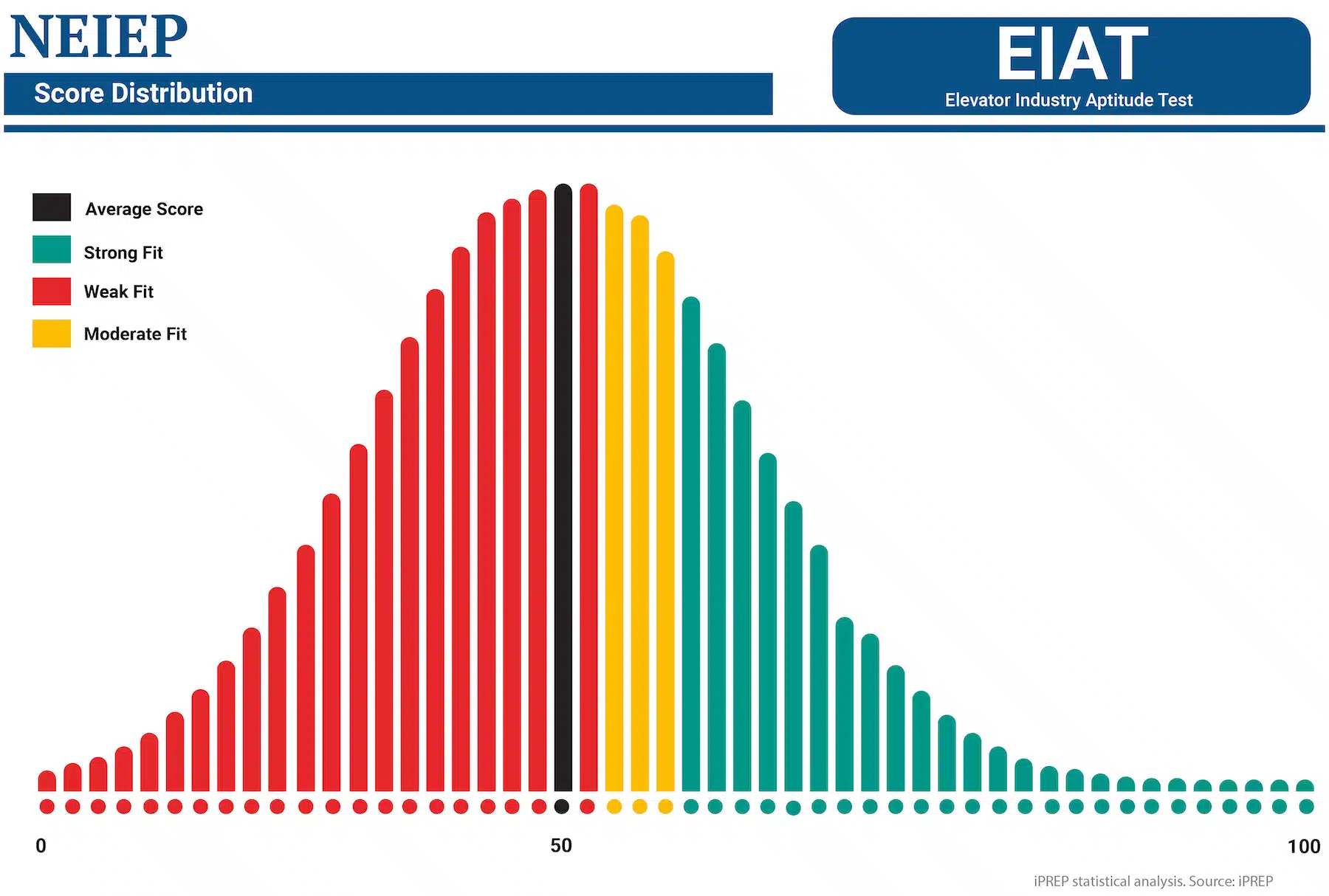
Well done!
You have completed the Sample Questions section.
The complete iPREP course includes full test simulations with detailed explanations and study guides.
‘…TESTS THAT ACTUALLY HELP’

In the first 30 minutes of use I have learned so much more than skipping along the internet looking for free content. Don’t waste you time, pay and get tests that actually help.
Richard Rodgers
January 28, 2020 at 7:49 PM
About the course
Includes 21 practice tests (2 full-length simulations)
Welcome to iPrep’s Elevator Industry Aptitude Test (EIAT) course.
This course will help you boost your skills and with it your confidence towards your upcoming aptitude test. This is the test that you need to pass in order to be accepted for the IUEC apprenticeship programs. The course will provide you with the following tools and benefits:
- You will become familiar with the test’s various types of questions.
- You will be given two EIAT-style simulation tests. Each simulation is divided into three sections – Arithmetic Computation, Verbal Skills, and Mechanical Comprehension. Each section includes similar questions to those you will encounter in the real test with the same level of difficulty. Experiencing the test’s time pressure will ensure it will not come as a surprise on test day.
- You will be provided with a great variety of helpful tips for the different types of questions. Some of the tips are in the introductory sections while most are in the detailed explanations that follow each question.
32
Learning hours
21
Practice tests
551
VIDEOS
500
Flashcards
By the end of this course, you will be more knowledgeable and comfortable with the aptitude test – Knowledge and familiarity with the test are the two most significant factors that can help you maximize your score and improve your chances of success.
The course is comprised of both practice and learning sessions. We will guide you through learning lessons with essential information about your upcoming elevator mechanic apprenticeship aptitude test. These lessons will help you understand the underlying techniques that are essential for succeeding on the test.
The course is then concluded by its core component – simulating timed EIAT-style tests that follow the structure and concepts of the elevator industry aptitude Test. Once done, you will be able to get full question explanations and even see how well you performed in comparison with other people who have taken the test.
Wishing you an enjoyable learning experience!
Skills you will learn
Basic math
Verbal skills
Mechanical comprehension
Tool recognition
Curriculum
- Course Introduction
- Question Types Introduction
- Basic Math
- Arithmetic Operations
- The Order of Operations
- Fractions and Decimals
- Verbal Skills
- Reading Comprehension
- Vocabulary
- Sentence Completion
- Mechanical Comprehension
- Simple Machines
- Basic Mechanical Forces
- Tool Recognition
- Test-Taking Tips
- Elevator Industry Aptitude Test-Style Simulations
- Course Conclusion
- Bonus Section: Getting Ready for the Interview
Customer Testimonial

Full of knowledge. I was much more prepared for the EIAT test. Would recommend to anyone looking to get in as an apprentice.
Billy Keller
August 20, 2019 at 6:44 PM
Reviews

Ricky J****
October 10, 2025 at 7:43 PM
I did not pass the elevator aptitude test. I didn't get a good enough score to get an interview. I didn't study long enough or often enough. I do like that what was in this study pack I felt less in the dark and knew what to expect to see on the test. So for that I'm giving a 4 star rating. It was the most affordable option that had the most material to review.

Jonathan B********
October 2, 2025 at 7:28 PM
iPrep is an excellent platform that offers clear, structured, and effective practice materials. It provides valuable guidance, detailed explanations, and helpful resources for exam preparation.

Justin M*******
September 29, 2025 at 3:27 AM
This whole prep course for this aptitude test was phenomenal. I took my test earlier this month and passed, and now I am waiting for the interview. All of the lesson were on the test and it definitely helped a lot.

Jose V*********
September 16, 2025 at 6:41 AM
So far iPrep has truly been excellent and very easy to access. Tons of information on each topic to help get you ready for exam. Very helpful and informative.

Kenneth E****
September 3, 2025 at 7:39 PM
Study your math. Those are easy unless you have not done them in along time like me. Also study your mechanical, those are a little tricky. With the help of IPREP I passed both aptitude test and interview. Thank you IPREP^^

DEVAN H*****
August 12, 2025 at 12:18 AM
Great help when it came to arithmetics and fluid dynamics. But very little help on the tape measure aspect of the tool test, as it was the only part without multiple choice. Very big let down that I aced everything besides one of the most important parts.

John V**********
August 9, 2025 at 10:08 AM
Great tool to use. I bought it 24hours before my. Test and passed it they don’t give u your score but it at least a 70%

Jonah C****
August 7, 2025 at 4:44 PM
Pro: the videos were easy to understand. Cons: Provided an overwhelming amount of information. Spent a lot of time reviewing content that was unnecessary. Some pages had obvious typos. The entirety of the tool section was ridiculously useless. The mechanical comprehension testing section was incredibly poorly written. I had zero issues understanding what was being asked in the actual EIAT. I will not be using this service again, and am actively encouraging others to find alternatives for studying.

iPrep
August 8, 2025 at 7:55 AM
Hi Jonah, thank you for sharing your feedback. We’re sorry to hear the course didn’t meet your expectations. While most of our users report a positive experience, we value all perspectives and will be reaching out to learn more from you.

Ryan G****
July 22, 2025 at 6:52 PM
Incredibly helpful in preparation of test and interview. Also has a lot of extras to make you feel 110% through the whole journey.
